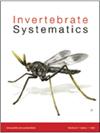基于 UCE 的鳞翅目内寄生蜂亚科 Rogadinae(膜翅目:腕蜂科)系统发生组学揭示了一个新的新热带部落。
摘要
在过去的二十年中,基于桑格、有丝分裂基因组和全基因组核 DNA 序列数据,对罗加迪纳亚科的系统发生关系和更高层次的分类做出了相关贡献。这些研究有助于更新该亚科的圈定和部族分类,目前已确认有六个部族(Aleiodini、Betylobraconini、Clinocentrini、Rogadini、Stiropiini 和 Yeliconini)。然而,Rogadinae内部的部落关系尚未完全确定,包括Facitorini部落(以前被认为是betylobraconini)相对于Yeliconini成员的地位。我们基于基因组超保留元素(UCE)数据和广泛的分类群取样,包括三个未被描述的、不确定部落位置的属,对Rogadinae各部落进行了系统进化分析。我们几乎完全支持的系统发育估计证实了 Rogadini 在该亚科和 Facitorini 支系(Yeliconini+Aleiodini)中的基干位置,这使我们提议将前者作为一个有效的rogadine 支系(Facitorini stat.)然而,Stiropiini首次被认为是除Rogadini以外的其余喙鸟类部落的姐妹群,而Clinocentrini则被认为是Betylobraconini+三个未描述属的一个支系的姐妹群。根据所发现的关系以及对所含材料进行的形态学检查,我们将后三个新属和最近描述的 Gondwanocentrus 属归入一个新的啮齿目,即 Gondwanocentrini Shimbori & Zaldívar-Riverón trib.nov。我们描述了这些属(Ghibli Shimbori & Zaldívar-Riverón gen. nov.、Racionais Shimbori & Zaldívar-Riverón gen. nov.和 Soraya Shimbori gen. nov.),每个属都有两到三个新种(G. miyazakii Shimbori & Zaldívar-Riverón sp. nov、新种、R. kaelejay Shimbori & Zaldívar-Riverón 新种、R. superstes Shimbori & Zaldívar-Riverón 新种、S. alencarae Shimbori 新种和 S. venus Shimbori & Zaldívar-Riverón 新种)。此外,还描述了 Facitorini 的一个新种 Jannya pasargadae Gadelha & Shimbori sp.我们新提出的分类法将Rogadinae中的族和属的数量分别扩大到了8个和66个。ZooBank: urn:lsid:zoobank.org:pub:51951C78-069A-4D8B-B5F0-7EBD4D9D21CE.During the past two decades, the phylogenetic relationships and higher-level classification of the subfamily Rogadinae have received relevant contributions based on Sanger, mitogenome and genome-wide nuclear DNA sequence data. These studies have helped to update the circumscription and tribal classification of this subfamily, with six tribes currently recognised (Aleiodini, Betylobraconini, Clinocentrini, Rogadini, Stiropiini and Yeliconini). The tribal relationships within Rogadinae, however, are yet to be fully resolved, including the status of tribe Facitorini, previously regarded as betylobraconine, with respect to the members of Yeliconini. We conducted a phylogenomic analysis among the tribes of Rogadinae based on genomic ultraconserved element (UCE) data and extensive taxon sampling including three undescribed genera of uncertain tribal placement. Our almost fully supported estimate of phylogeny confirmed the basal position of Rogadini within the subfamily and a Facitorini clade (Yeliconini+Aleiodini) that led us to propose the former group as a valid rogadine tribe (Facitorini stat. res.). Stiropiini, however, was recovered for the first time as sister to the remaining rogadine tribes except Rogadini, and Clinocentrini as sister to a clade with Betylobraconini+the three undescribed genera. The relationships recovered and morphological examination of the material included led us to place the latter three new genera and recently described genus Gondwanocentrus within a new rogadine tribe, Gondwanocentrini Shimbori & Zaldívar-Riverón trib. nov. We described these genera (Ghibli Shimbori & Zaldívar-Riverón gen. nov., Racionais Shimbori & Zaldívar-Riverón gen. nov. and Soraya Shimbori gen. nov.) with two or three new species each (G. miyazakii Shimbori & Zaldívar-Riverón sp. nov., G. totoro Shimbori & Zaldívar-Riverón sp. nov., R. brunus Shimbori & Zaldívar-Riverón sp. nov., R. kaelejay Shimbori & Zaldívar-Riverón sp. nov., R. superstes Shimbori & Zaldívar-Riverón sp. nov., S. alencarae Shimbori sp. nov. and S. venus Shimbori & Zaldívar-Riverón sp. nov.). A new species of Facitorini, Jannya pasargadae Gadelha & Shimbori sp. nov., is also described. Our newly proposed classification expands the number of tribes and genera within Rogadinae to 8 and 66 respectively. ZooBank: urn:lsid:zoobank.org:pub:51951C78-069A-4D8B-B5F0-7EBD4D9D21CE.

 求助内容:
求助内容: 应助结果提醒方式:
应助结果提醒方式:


